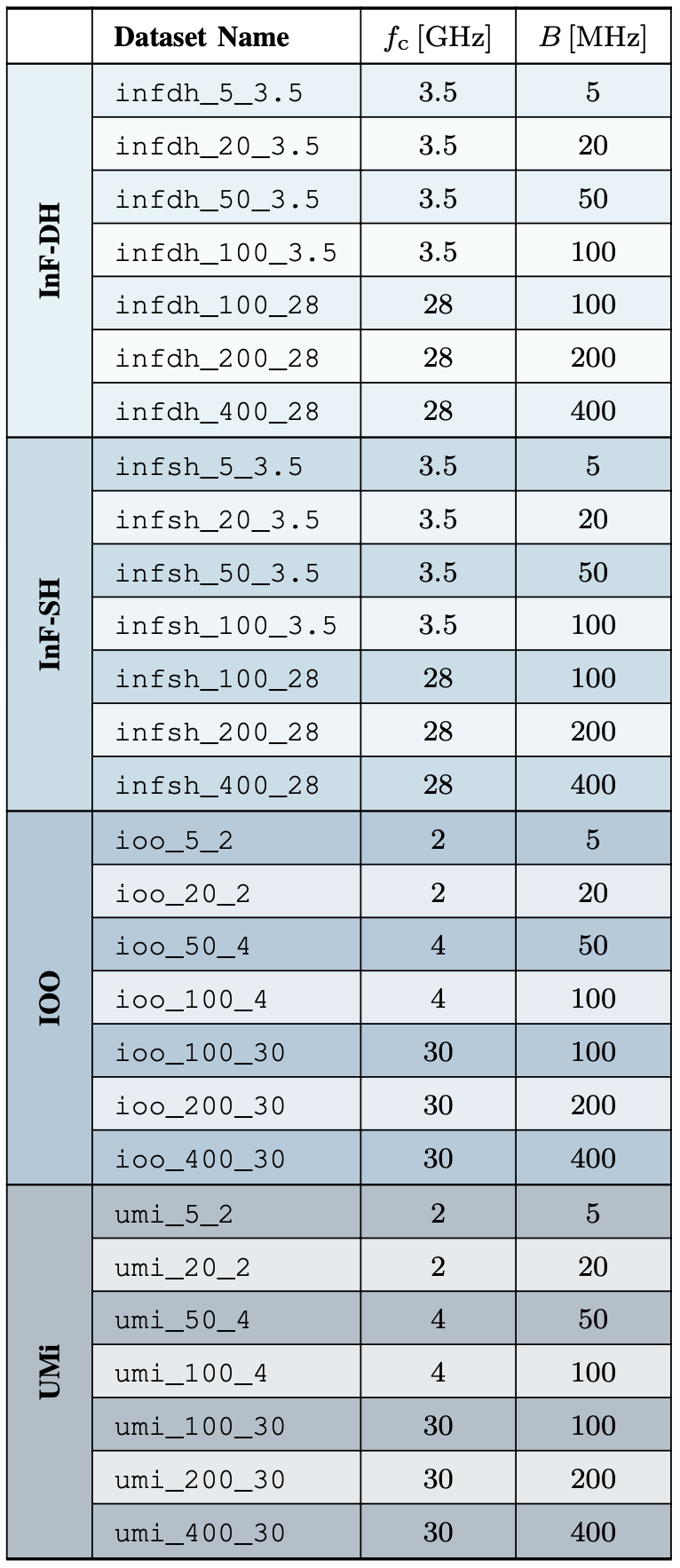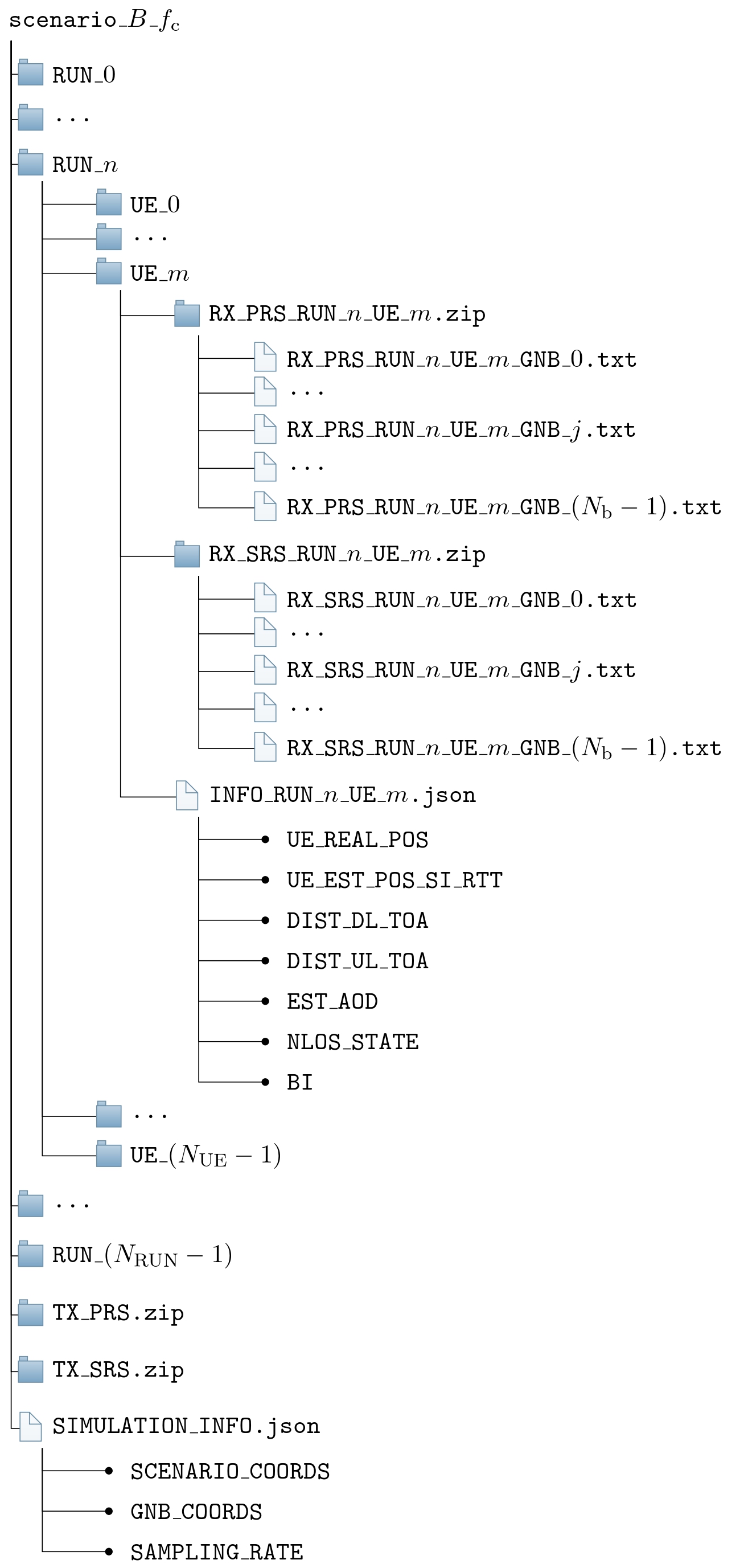Datasets
Open Access
xG-Loc: 3GPP-compliant datasets for xG location-aware networks
- Citation Author(s):
- Submitted by:
- Andrea Conti
- Last updated:
- Wed, 12/13/2023 - 03:44
- DOI:
- 10.21227/rper-vc03
- Research Article Link:
- License:
 810 Views
810 Views- Categories:
- Keywords:
Abstract
Location awareness is vital in next generation (xG) wireless networks to enable different use cases, including location-based services (LBSs) and efficient network management. However, achieving the service level requirements specified by the 3rd Generation Partnership Project (3GPP) is challenging. This calls for new localization algorithms as well as for 3GPP-standardized scenarios to support their systematic development and testing. In this context, the availability of public datasets with 3GPP-compliant configurations is essential to advance the evolution of xG networks.
xG-Loc is the first open access dataset for localization algorithms and services fully compliant with 3GPP technical reports and specifications. xG-Loc includes received localization signals, measurements, and analytics for different network and signal configurations in indoor and outdoor scenarios with center frequencies from micro-waves in frequency range 1 (FR1) to millimeter-waves in frequency range 2 (FR2). Position estimates obtained via soft information-based localization and wireless channel quality via blockage intelligence are also included in xG-Loc. The rich set of data provided by xG-Loc enables the characterization of localization algorithms and services under common 3GPP-standardized scenarios in xG networks.
The following instructions summarize the xG-Loc [1] structure and characteristics, which are described in detail in the open access associate publication [2].
xG-Loc is structured into 28 compressed directories, representing 28 possible configurations of 3GPP-standardized scenarios, bandwidth B, and central frequencies fc both in FR1 at microWaves and in FR2 at mmWaves.
Specifically, the scenarios considered are:
- 3GPP 38.901 Indoor factory dense-high (InF-DH)
- 3GPP 38.901 Indoor factory sparse-high (InF-SH)
- 3GPP 38.901 Indoor open office (IOO)
- 3GPP 38.901 Urban microcell (UMi)
The directory naming convention is scenario_B_ fc. For example, the directory containing the data for the UMi scenario with 200MHz bandwidth and a central frequency of 30GHz is named umi_200_30.zip. The configurations available in xG-Loc are reported in the following table:

Each configuration directory includes 100 instantiations (each of which referred to as RUN) of the 3GPP-standardized scenario. At each RUN, the random parameters of the scenario, including the wireless channel characteristics and non-line-of-sight (NLOS) conditions are re-computed. For each RUN, 10 user equipments (UEs) are deployed with random positions and orientations. The structure of the directories is as follows:

A simple example showing how data can be read from a configuration directory of xG-Loc is reported in the Matlab file read_files.m.
In more detail, for each UE, two compressed folders are provided, which respectively include:
- received positioning reference signals (PRSs) for each wireless link between the UE and the base stations;
- received sounding reference signals (SRSs) for each wireless link between the UE and the base stations;
The transmitted PRS and SRS are also provided.
In addition, some synthetic data and analytics are reported in a json file, including:
- distance estimates in downlink based on the PRS transmission for each wireless link between the UEs and the base stations;
- distance estimates in uplink based on the SRS transmission for each wireless link between the UEs and the base stations;
- angle-of-departure (AOD) estimates based on the PRS transmission with beam-sweeping for the indoor scenarios in FR2;
- estimates of the UEs position via soft information (SI)-based localization [3],[4],[5];
- estimates of the wireless channel quality via blockage intelligence (BI) [6] for each link between the UEs and the base stations; and
- other additional information useful to evaluate the performance of location-aware networks.
Note
If using xG-Loc, include explicit citation to both xG-Loc IEEE DataPort [1] and its associated publication [2]. If using specific features of xG-Loc, such as estimates of the UE position via SI-based localization [3],[4],[5] or estimates of the wireless channel quality via BI [6], also include explicit citation to the related publications.
We suggest using a sentence as follows:
"To evaluate the performance of the algorithm, we use xG-Loc, a 3GPP-compliant dataset for next generation (xG) location-aware networks [1],[2]."
Acknowledgment
The fundamental research connected to xG-Loc was supported, in part, by the Office of Naval Research under Grant N62909-22-1-2009, by the National Science Foundation under Grant CNS-2148251, and by federal agency and industry partners in the RINGS program.
References
[1] A. Conti, G. Torsoli, C. A. Gómez-Vega, A. Vaccari, and M. Z. Win, “xG-Loc: 3GPP-compliant datasets for xG location-aware networks,” IEEE Dataport, 2023. [Online]. Available: https://dx.doi.org/10.21227/rper-vc03
[2] A. Conti, G. Torsoli, C. A. Gómez-Vega, A. Vaccari, G. Mazzini, and M. Z. Win, “3GPP-compliant datasets for xG location-aware networks,” IEEE Open J. Veh. Tech, 2023, early access
[3] A. Conti, S. Mazuelas, S. Bartoletti, W. C. Lindsey, and M. Z. Win, “Soft information for localization-of-things,” Proc. IEEE, vol. 107, no. 11, pp. 2240-2264, Nov. 2019.
[4] A. Conti, F. Morselli, Z. Liu, S. Bartoletti, S. Mazuelas, W. C. Lindsey, and M. Z. Win, Location awareness in beyond 5G networks, IEEE Commun. Mag., vol. 59, no. 11, pp. 2227, Nov. 2021
[5] F. Morselli, S. M. Razavi, M. Z. Win, and A. Conti, “Soft information based localization for 5G networks and beyond,” IEEE Trans. Wireless Commun., vol. 22, pp. 1-16, 2023, early access.
[6] G. Torsoli, M. Z. Win, and A. Conti, “Blockage intelligence in complex environments for beyond 5G localization,” IEEE J. Sel. Areas Commun., vol. 41, no. 6, pp. 1688-1701, Jun. 2023.
For more information, visit wcln.unife.it
Dataset Files
infdh_5_3.5.zip (1.63 GB)
infdh_100_28.zip (20.58 GB)
infdh_400_28.zip (40.91 GB)
infdh_200_28.zip (40.98 GB)
infsh_5_3.5.zip (1.63 GB)
infsh_20_3.5.zip (6.85 GB)
infsh_50_3.5.zip (6.85 GB)
infsh_100_3.5.zip (13.66 GB)
infsh_100_28.zip (20.59 GB)
infsh_200_28.zip (41.00 GB)
infsh_400_28.zip (40.92 GB)
ioo_5_2.zip (1.08 GB)
ioo_20_2.zip (4.54 GB)
ioo_50_4.zip (4.55 GB)
ioo_100_4.zip (9.07 GB)
ioo_100_30.zip (13.72 GB)
ioo_200_30.zip (27.33 GB)
ioo_400_30.zip (27.29 GB)
umi_5_2.zip (5.17 GB)
umi_20_2.zip (21.70 GB)
umi_100_4.zip (43.35 GB)
umi_100_30.zip (21.75 GB)
umi_200_30.zip (43.33 GB)
umi_400_30.zip (43.23 GB)
infdh_20_3.5.zip (6.85 GB)
infdh_50_3.5.zip (6.86 GB)
infdh_100_3.5.zip (13.67 GB)
umi_50_4.zip (21.70 GB)
read_files.m (2.29 kB)
Open Access dataset files are accessible to all logged in users. Don't have a login? Create a free IEEE account. IEEE Membership is not required.






